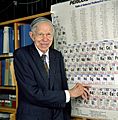Seaborgium facts for kids
| Seaborgium | |||||||||||||||||||||||||||||||||||
|---|---|---|---|---|---|---|---|---|---|---|---|---|---|---|---|---|---|---|---|---|---|---|---|---|---|---|---|---|---|---|---|---|---|---|---|
| Pronunciation | |||||||||||||||||||||||||||||||||||
| Mass number | 269 | ||||||||||||||||||||||||||||||||||
| Seaborgium in the periodic table | |||||||||||||||||||||||||||||||||||
|
|||||||||||||||||||||||||||||||||||
| Atomic number (Z) | 106 | ||||||||||||||||||||||||||||||||||
| Group | group 6 | ||||||||||||||||||||||||||||||||||
| Period | period 7 | ||||||||||||||||||||||||||||||||||
| Block | d | ||||||||||||||||||||||||||||||||||
| Electron configuration | [Rn] 5f14 6d4 7s2 | ||||||||||||||||||||||||||||||||||
| Electrons per shell | 2, 8, 18, 32, 32, 12, 2 | ||||||||||||||||||||||||||||||||||
| Physical properties | |||||||||||||||||||||||||||||||||||
| Phase at STP | solid (predicted) | ||||||||||||||||||||||||||||||||||
| Density (near r.t.) | 35.0 g/cm3 (predicted) | ||||||||||||||||||||||||||||||||||
| Atomic properties | |||||||||||||||||||||||||||||||||||
| Oxidation states | 0, (+3), (+4), (+5), +6 (parenthesized: prediction) | ||||||||||||||||||||||||||||||||||
| Ionization energies |
|
||||||||||||||||||||||||||||||||||
| Atomic radius | empirical: 132 pm (predicted) | ||||||||||||||||||||||||||||||||||
| Covalent radius | 143 pm (estimated) | ||||||||||||||||||||||||||||||||||
| Other properties | |||||||||||||||||||||||||||||||||||
| Natural occurrence | synthetic | ||||||||||||||||||||||||||||||||||
| Crystal structure | body-centered cubic (bcc)
(predicted) |
||||||||||||||||||||||||||||||||||
| CAS Number | 54038-81-2 | ||||||||||||||||||||||||||||||||||
| History | |||||||||||||||||||||||||||||||||||
| Naming | after Glenn T. Seaborg | ||||||||||||||||||||||||||||||||||
| Discovery | Lawrence Berkeley National Laboratory (1974) | ||||||||||||||||||||||||||||||||||
| Main isotopes of seaborgium | |||||||||||||||||||||||||||||||||||
|
|||||||||||||||||||||||||||||||||||
Seaborgium is a chemical element. In the past, it has been named eka-tungsten but is now named seaborgium. It has the symbol Sg. It has the atomic number 106. Seaborgium is a radioactive element that does not exist in nature. It has to be made. The most stable isotope is 271Sg. Seaborgium-271 has a half-life of 2.4 minutes.
What Seaborgium looks like is not known because not enough has been made to see it with human eyesight, but since it is in the same period as Tungsten in the periodic table, it's appearance and may be similar to such.
The element is named in honor of Glenn Seaborg.
Seaborgium is a transuranium element. This means that it is "beyond" (trans) the element Uranium in the sequence of elements.
Mendeleev predicted that Seaborgium would exist. He called the element eka-tungsten because of its location was near Tungsten in the Periodic Table. The chemistry of seaborgium is like the chemistry of tungsten.
Images for kids
-
Element 106 was named after Glenn T. Seaborg, a pioneer in the discovery of synthetic elements, with the name seaborgium (Sg).
See also
 In Spanish: Seaborgio para niños
In Spanish: Seaborgio para niños





